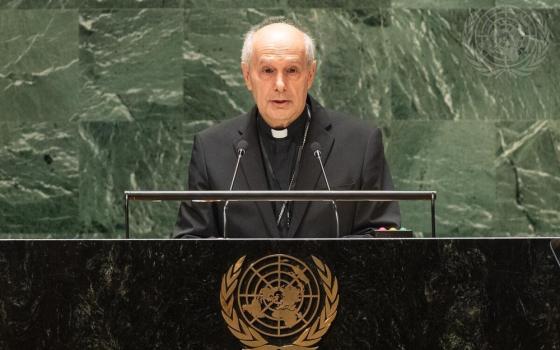“I wish I could live in that garden.”
Such was the reaction of one happy little girl who had helped to tend and taste the luscious bounty of tomatoes, lettuce and carrots growing at the St. Vincent Family Center in Columbus, Ohio, last summer.
The 10-year-old had been participating in a learning garden for kids, sponsored by Growing Matters, a non-profit organization that teaches families in the inner city of Ohio’s state capital about growing food, good nutrition and cooking.
Jesse Hickman, program manager, related this episode during a breakout session at the Earthkeeping Summit, held Oct. 12-13 at the Ohio State University. Hickman was among more than a dozen speakers at the two-day event, presented by Ohio Interfaith Power and Light and OSU’s School of Environmental and Natural Resources.
In retrospect, his anecdote about a child delighting in growing things, and wanting to live alongside them, symbolically described the question reverberating throughout the conference: How to bring Earth’s Garden back to health so that everyone, especially the poor and disenfranchised, benefits and delights?
Individual presentations -- ranging from transforming food systems, to increasing energy stewardship, to developing a green university campus and corresponding community -- planted their own seeds of hope, adding up to an abundance of encouraging takeaways for the 150 attendees.
Katharine Hayhoe, director of Texas Tech University’s Climate Science Center and co-author of A Climate for Change: Global Warming Facts for Faith-based Decisions, keynoted the Sunday evening opening session.
Hayhoe, an evangelical Christian, spoke of her efforts to convince religious fundamentalists that climate change is real, and to acknowledge that that fact does not compromise one’s religious faith.
When challenged by deniers, she often responds, “The New Testament talks about how faith is the evidence of things not seen, while science is the evidence of things that are seen.” These are two sides of the same coin, she explains.
Hayhoe offers the reminder that Christianity’s basic message is to demonstrate love and care to our neighbors, whether they’re known personally or not – a point of particular importance when it comes to climate change and the disproportionate affects it has on the poor and vulnerable. Look at the realities of climate change through the lens of our hearts, instead of through politics, Hayhoe urges.
Climate change again entered a dialogue on the morning of Oct. 13, as David Orr, an environmental professor at Oberlin College, and his minister son, Daniel, rector of St. Paul’s Episcopal Church in Fremont, Ohio, spoke about the issue and earth keeping from an intergenerational perspective.
David Orr, the Paul Sears Distinguished Professor of Environmental Studies and Politics at Oberlin, also directs the Oberlin Project -- a cooperative sustainability effort between the school and the city, sponsored by the Clinton Climate Initiative Global Project, that aims to build a post-fossil fuel economy in Oberlin.
By 2015, Oberlin is set to reduce carbon emissions by 50 percent of its 2007 levels, with 90 percent of its electricity from renewables, according to the website.
In 1995 Orr and 250 Oberlin students began designing the Adam Joseph Lewis Center for Environmental Studies. Dedicated in 2000, the all-electric photovoltaic building produces zero emissions; a greenhouse it houses features a self-contained waste and water purification system.
“When you engage students in building a building, you are giving them hope,” Orr told the conference.
He said his students established basic ground rules for the green building: “They wanted a structure that would not do any damage to the forests. They wanted to know where the carpets would come from and to make certain that the total project would not violate human dignity in any way.”
Engaging them in an active project was enlivening and positive, he said, while on the flip side, introducing numbers, charts and graphs about environmental abuse “was incredibly depressing to the kids.”
Orr said he would engage in environmental design “even if there were no crisis. I love the water, the rocks, and the soil.”
He asked his son what it would take for the churches to become front and center in the climate issue. In prefacing his question, the elder Orr said, “Human change begins with communities, and right now we are sending more bads than goods into the future.” So how can we begin to change the situation, he asked?
Daniel Orr replied that much institutional change, such as speaking out against racism, started with the church community. He saw a revival of activism in the areas of the environment and climate as using some of the difficult Scriptural references for the starting point.
“As Americans we want to fix things,” Daniel Orr said. “We want joy, but we have to attend to sorrow around the earth’s abuse first. Walter Brueggeman once said when you have the prophets warning ‘Woe to you,’ these are the hard passages people want to avoid. But if we don’t feel the sorrow and share it, our moving forward will be too shallow.”
The Episcopal priest said the Hebrew word “shamor” means keeping, guarding and preserving -- a concept that Joseph honored when he became governor in Egypt, behind only the pharaoh.
Joseph knew about keeping so well, Daniel Orr said, that he enabled Egypt and the poor countries around it to survive during the seven years of drought.
Shamor, however, has been neglected in our contemporary society, said David Orr.
“There are 24 million things available on Amazon. Where is the message of sorrow in a consumer society?” he asked.




